Best Polish Movies – TOP 75 Polish Films
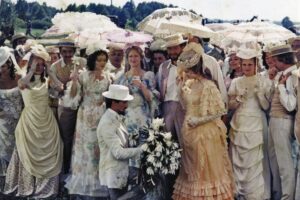
More than 100 years have passed since the screening of the first Polish film – “Antos po raz pierwszy w Warszwie” in 1908. Polish cinema encountered many obstacles on its way: two world wars and later censorship restrictions significantly affected the specifics of national cinematography. The leading trend of filmmaking obviously became a focus on domestic history, politics and social change. However, the achievements of Polish cinema also include cult comedies, moral positions or artistic experiments. Here is our selection of the 75 best Polish movies.
Polish movies – a brief history
Poland’s first cinematograph screening took place in Krakow in 1896. Twelve years later, a pioneering domestic film starring Antoni Fertner was produced. By the 1930s, the SFINKS film studio led the way, with Pola Negri becoming a big star, and after she left for Germany, Jadwiga Smosarska became the object of viewers’ adoration. Sound entered Polish cinema in 1930 with the film “The Morality of Mrs. Dulska”. From then on, the most important genre of pre-war Polish cinema was the comedy modeled on the Hollywood genre – the “great love story” with a large role for music. It is the hits from this era that are today the most recognizable mark of Polish interwar film.
The second significant genre of the pre-war era were melodramas, especially those referring to the tragic history of Poland or screen adaptations of the prose of Helena Mniszkówna and Maria Rodziewiczówna. The stars of Elzbieta Barszczewska, Tola Mankiewiczówna, Loda Halama or Zula Pogorzelska shone most brightly on the pantheon. Among the romances, Aleksander Żabczyński reigned supreme, but viewers also loved Adolf Dymsza, Eugeniusz Bodo, Józef Węgrzyn or – considered the most outstanding actor of the era – Kazimierz Junosza-Stępowski.
Socialist realism and the Thaw in Polish film
World War II interrupted the development of Polish cinema, the underground boycotted this entertainment then in the hands of the German occupiers, and most of the pre-war actors met a tragic fate. After the war, the first Polish feature film became the still beloved “Forbidden Songs” (1946). In 1949, at the Vistula Convention, Socialist Realism was declared the prevailing doctrine in the arts, which for several years trapped Polish cinema within a framework of extremely ideologized and boring messages. It was not until the Thaw period heralded by Andrzej Wajda’s “A Generation” (1954) and then “Kanal” (1956) that Polish film was brought out onto the international circuit. At that time, the Polish Film School was established, signed with the names of the aforementioned Wajda, Andrzej Munk, but also screenwriter J. S. Stawinski or actors: Zbigniew Cybulski, Tadeusz Janczar. At the same time, individual style cinema began to appear, such as the works of Kawalerowicz or Tadeusz Konwicki.
The freedom of the Thaw period was very quickly curtailed by censorship, and the return of ideologically influenced works began again, especially in the trend of great historical spectacles. The events of March 1968 and the ensuing political crisis resulted in cinema inspired by the French New Wave, i.e. the works of Krzysztof Zanussi or Jerzy Skolimowski. A separate group was the mythology of a small homeland – Silesia – in the works of Kazimierz Kutz.
Polish film from the cinema of moral anxiety to the present day
The second half of the 1970s, with the premiere of Wajda’s “Man of Marble” (1977), brought in turn the current of the Cinema of Moral Anxiety, which can include the films of Krzysztof Kieslowski, Agnieszka Holland, Feliks Falk and K. Zanussi. The 1970s was also a period of triumph for popular cinema, especially the great comedies of Stanislaw Bareja. The imposition of martial law in 1981 once again halted the release of many important films, which saw the light of day only at the end of the decade. This was also when Krzysztof Kieslowski’s films achieved worldwide success.
The turn of 1989 for Polish cinema proved to be very difficult – domestic cinematography was in crisis. The audience’s interest in politics and history naturally waned, while one of the most important currents became “bandit cinema” showing systemic and mental transformations after the fall of communism. The most emblematic example of this current is Wladyslaw Pasikowski’s “Pigs”. More important works of recent decades are also adaptations of literature, films by A. Kondratiuk and a focus on social problems, for example, in the works of Krzysztof Krauze. In recent years, one can also see a developing trend of women’s cinema, and one of its representatives, Malgorzata Szumowska, is achieving significant international success.
Best Polish movies
1. ”Mocny człowiek” (1929)
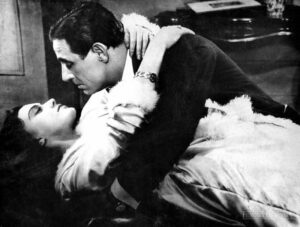
The film “Mocny człowiek” is an outstanding item of Polish silent cinema. The adaptation of Stanislaw Przybyszewski’s prose, directed by Henryk Szaro, shows the psychological drama of a budding writer, while delightfully portraying pre-war Warsaw. The main character of the picture is a young journalist, Henryk Bielecki (Gregori Chmara), who dreams of a literary career. Thus, by deception, he steals the manuscript of his friend Jerzy Górski (Artur Socha) and indirectly contributes to his death. But will the man be able to cope with the crushing stigma of guilt? “Mocny człowiek” is an example of inspiration from German Expressionism, as well as a poetic portrait of pre-war Warsaw.
2. “Zapomniana melodia” (1938)
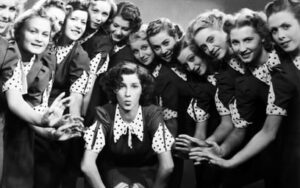
Although Polish pre-war cinema did not abound in great masterpieces, its strongest point was musical comedies. The hits from comedy films of the interwar period have survived in our consciousness to this day and have become an integral part of Polish popular culture. One of the best works of this genre is “Zapomniana melodia”, directed by Konrad Tom and Jan Fethke. The plot of the film concerns the love adventures of a couple in love: Helenka Roliczówna (Helena Grossówna) from the Girls’ Training Institute and Stefan Frankiewicz (Aleksander Żabczyński). The beautiful music for “Zapomniana melodia” was composed by Henryk Wars, and the songwriter was Ludwik Starski. It is from this film that such hits as Już nie zapomnisz mnie, Ach, jak przyjemnie! or Mr. Jan!
3. “Neighbors” (“Piętro wyżej”, 1937)
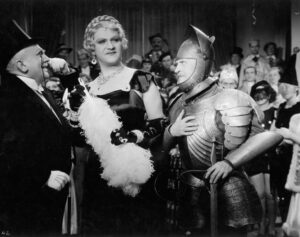
Among Polish pre-war comedies, Leon Trystan’s “Neighbors” is also worth mentioning, if only for the outstanding performance of the great personality of the era – Eugeniusz Bodo. The story takes place in one of Warsaw’s tenements on Happy Street, where two bachelors with the same surname Pączek live. Naturally, this coincidence leads to a huge rift between the neighbors. However, everything changes when one of the gentlemen is visited by his pretty niece Lodzia (Helena Grossówna). “Neigbors” went down in the history of Polish cinema because of its cult hits, such as Umowiłem się z nią na dziewiątą and “SexAppeal”. The latter hit in the guise of Mae West is performed on screen by the incomparable Bodo.
4. “Forbidden Songs” (“Zakazane piosenki”, 1946)
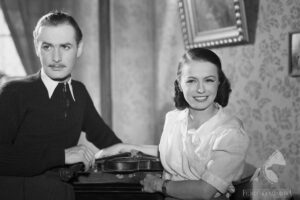
“Forbidden Songs”, directed by Leonard Buczkowski, is the first Polish post-war feature film. The picture depicts the history of the German occupation from September 1939 to May 1945 in a very scodgy, fabricated form. Its leitmotif is the “forbidden songs” of the title – that is, the music that helped people survive during this difficult time. Sometimes these were clandestine concerts of works by Frederic Chopin, but above all, almost heroic performances by street bands and singers, who on street corners and in the backyards of tenements performed pieces that gave their compatriots encouragement. The main roles in the film were played by Danuta Szaflarska and Jerzy Duszyński.
5. “Kanal” (1956)
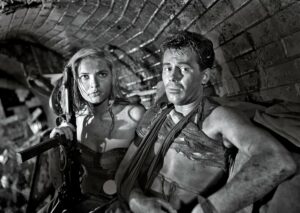
Andrzej Wajda launched the current of the Polish Film School, shooting the still social-realistic and propagandistic, but nonetheless outstanding Generation. His next major work, meanwhile, was “Kanal”, which was the first film after the Stalinist era to tackle the hitherto forbidden subject of the Warsaw Uprising. The film is set at the end of the insurrection, when Lieutenant “Zadra” (Wienczyslaw Glinski) tries to get through the sewers to the Srodmiescie with his unit. Also playing important roles in the film were Tadeusz Janczar (as cadet “Korab”) and Teresa Iżewska (as liaison officer “Stokrotka”). Wajda’s work was awarded the Silver Palm at the Cannes Festival.
6. “Heroism” (“Eroica”, 1957)
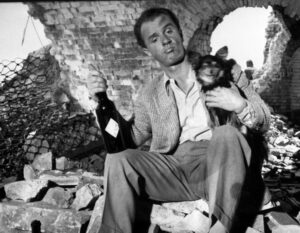
“Heroism”, in turn, is an outstanding film by Andrzej Munk, which is an artistic and ideological response to Wajda’s “Kanal”. The work was based on the short stories of Jerzy Stefan Stawinski. The first part, Scherzo alla polacca, depicts the story of a certain “Dzidzius” Górkiewicz (Edward Dziewoński), who tries to negotiate the support of a Hungarian military unit during the Warsaw Uprising. The plot of the film’s second link, Ostinato Lugubre, on the other hand, is set in a German camp for Polish prisoners of war. In his work, Munk reckons with national myths and depicts wartime events through grotesque humor, conveying both their horror and the absurdity of human behavior. The film was awarded the FIPRESCI Prize and the Grand Prix at the Argentina International Film Festival.
7. “Ashes and Diamonds” (“Popiół i diament”,1958)
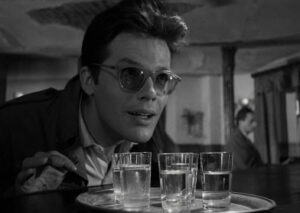
Andrzej Wajda’s masterpiece, “Ashes and Diamonds”, created a new type of hero in Polish cinema, whose icon became Zbigniew Cybulski. He became the symbol of a new generation, and his image and style of behavior resembled James Dean. The film adaptation of Jerzy Andrzejewski’s novel is undoubtedly one of the most important Polish films. The picture is set just after the end of World War II, when broken Home Army units are trying to find their way in the new communist reality. One of the Home Army soldiers, Maciek Chelmicki, is ordered to carry out a death sentence on a socialist activist, Szczuka. The scene of Chelmicki’s death, despite the clear propaganda message of the film (it was impossible to avoid it at the time), has become a telling symbol of the dramatic fate of the Home Army, as it were, thrown by the new authorities into the dustbin of history.
8. “Bad Luck” (“Zezowate szczęście”, 1960)
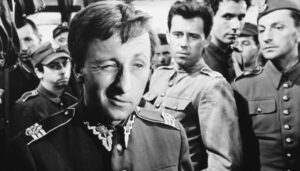
Another masterpiece by Andrzej Munk, “Bad Luck”, like “Heroism” uses the grotesque to show the “giggle” of Polish history. The main character of the film, based on the prose of Jerzy Stefan Stawinski, is Jan Piszczyk (Bogumił Kobiela), whose fate makes it possible to present an extensive slice of domestic history, from the interwar era to Stalinism. And this is, of course, an ironic picture, since Piszczyk is a typical commie, who in all political circumstances tries to conform to the prevailing ideology. This attitude becomes the cause of many tragicomic events.
9. ”Night Train” (“Pociąg”, 1959)
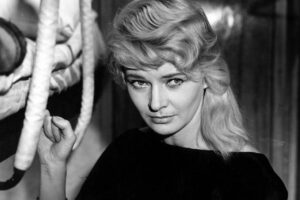
Jerzy Kawalerowicz’s “Night Train” was awarded the Georges Mellies Technical Prize at the Venice Film Festival. It is a quasi-criminal story with a clear psychological foundation. The main characters are a young lady meteorologist and a surgeon who travel in the same compartment by train from Warsaw to Hel. During the journey, it turns out that there is also a fugitive murderer on the train… Critics especially appreciated the performance of the opposite of the main role, Lucyna Winnicka.
10. ”The Noose”, (“Pętla”,1957)
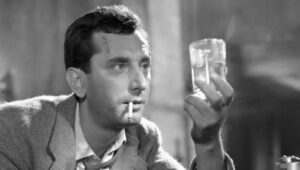
“The Noose” is a memorable film by Wojciech Jerzy Has with Gustaw Holoubek in the lead role. The director was inspired by Marek Hłasko’s short story of the same title from his famous volume “First Step into the Clouds”. The movie tells the tragic story of Kuba, a young man addicted to alcohol, who, with the help of his fiancée Krystyna (played by Aleksandra Slaska), tries unsuccessfully to fight his addiction. Everything is heading to a tragic finale… Loop is a work in which one can find tropes of many artistic directions, such as expressionism, existentialism and American cinema noir.
11. ”Goodbye, See You Tomorrow” (“Do widzenia, do jutra”, 1960)
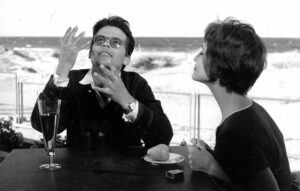
Janusz Morgenstern’s debut, “Goodbye, See You Tomorrow”, immediately made its mark in the history of Polish cinema. The movie depicts a love story set in the Tricity. Jacek, a young student (played by Zbigniew Cybulski) falls in love with the beautiful daughter of the French consul named Margueritte (Teresa Tuszyńska). However, the girl is indecisive, and one day she leaves without saying goodbye… It is worth mentioning that a great asset of the film is its jazz music, by Krzysztof Komeda.
12. ”The Last Day of Summer” (“Ostatni dzień lata”, 1958)
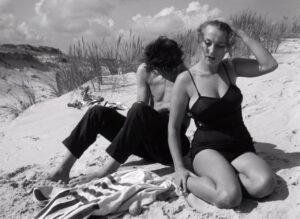
“The Last Day of Summer” is, in turn, the high-profile film debut of Tadeusz Konwicki, who previously worked in literature and had an episode with socialist realism. The picture is a rather enigmatic whole without a clear plot or detailed characters. In fact, the characters in the film are an unnamed man and woman who meet on the beach at the end of a hot vacation. A special kind of attachment develops between them. The leading roles were played by Jan Machulski and Irena Laskowska.
13. “Knife in the Water” (“Nóż w wodzie”, 1961)

The movie “Knife in the Water” opened the way for Roman Polanski’s international career. The picture was awarded at the Venice Film Festival and won an Oscar nomination. It is a story set in the Mazurian Lake District. A married couple on a hot day goes out on a yacht for a cruise on the lake. Unexpectedly, they meet a young man and take him on board. The men begin to compete with each other. Starring Leon Niemczyk, Jolanta Umecka and Zygmunt Malanowicz.
14. “How to Be Loved” (“Jak być kochaną”, 1962)
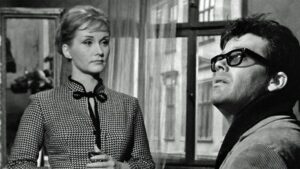
Wojciech Jerzy Has made the film “How to be Loved”, based on a short story by Kazimierz Brandys. The picture is a war drama that tells the story of the efforts of a young actress, Felicia, to save her beloved from arrest. However, Victor Rawicz, who she hides, does not reciprocate the woman’s love… Starring Barbara Krafftówna and Zbigniew Cybulski. The film was awarded in San Francisco and Beirut.
15. “Salto” (1965)
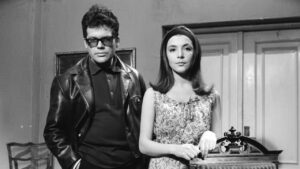
Tadeusz Konwicki’s “Salto” was appreciated domestically, but also gained international acclaim. The film is set in a provincial town in western Poland. One day a mysterious man shows up there, to whom the residents attribute various versions of identity. The newcomer gains enormous influence over the local community. The role of the man was played by Zbigniew Cybulski. The film is a reckoning with the Polish film school, but also with romantic national myths.
16. “All Friends Here” (“Sami swoi”, 1967)
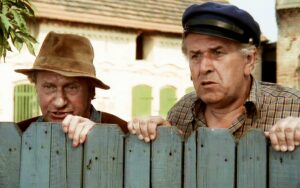
This is one of the cult Polish comedies – “All Friends Here”, directed by Sylwester Chęciński, took the hearts of Polish audiences by storm and continues to do so to this day. The story takes place just after the war in the Recovered Territories, where two families, the Pawlaks and the Karguls, displaced from the Borderlands, arrive. The neighbors have been feuding with each other since before the war over property and a cow. The feuds also spill over into the area of the new house. The chance to reconcile the families, however, may turn out to be the love between Kargul’s daughter Jadźka (Ilona Kuśmierska) and the Pawlaks’ son Witia (Jerzy Janeczek). The film starred Władysław Hańcza (as Kargul) and Wacław Kowalski (Pawlak). In the next decade two more parts of the series were filmed: “Take it Easy” (1974) and “Love or Leave” (1977).
17. “The Saragossa Manuscript” („Rekopis znaleziony w Saragossie”, 1964)

Jan Potocki’s eighteenth-century work “The Saragossa Manuscript” was used by Wojciech Jerzy Has to make a masterpiece film. The lead role was played by Zbigniew Cybulski, who played Alfonso von Worden, a Spanish officer making the long journey from Zaragoza to Madrid. The road, however, is only a compositional framework for a whole composed of many different stories. The structure of Has’s film replicates the structure of Potocki’s novel, based on a casket narrative. Interestingly, “The Saragossa Manuscript” made an incredible splash in the United States, and many of the greatest masters of cinema count it among the most important works in the history of the X Muse.
18. ”The Matthew’s Days” (“Żywot Mateusza”, 1967)

Vytautas Leszczynski’s movie ”The Matthew’s Days” is a poetic story about a rural out-sider who finds himself in better relationships with animals and nature than with people. The man lives by a lake with his sister Olga, who helps him with his daily chores. The role of the titular Mateusz was created by Franciszek Pieczka, and the role has become one of the most important in his artistic output. The film was based on a novel by Tarjei Vesaas. It was awarded at Cannes, Valladolid and in Colombo.
19. ”The Doll” (“Lalka”, 1968)
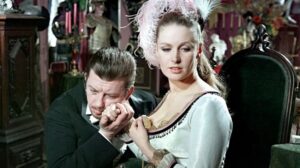
“The Doll”, directed by Wojciech Jerzy Has, is one of the most important screen adaptations of Polish literature. The film was based on the novel by Boleslaw Prus. The main character of the work is Stanislaw Wokulski, a wealthy capitalist who falls in love without reciprocation with a beautiful woman from an aristocratic but indebted family, Izabela Lecka. The man decides to win the favor of his chosen one at all costs. The role of Wokulski was played by Mariusz Dmochowski, while Izabella was played by Beata Tyszkiewicz.
20. “The Cruise” (“Rejs”, 1970)
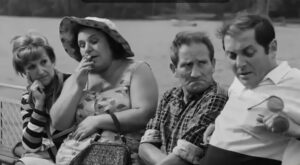
Marek Piwowski’s comedy “The Cruise” is already a classic of Polish cinema and one of its cult pictures. The plot frame of the work is the title cruise on a cruise ship from Warsaw to Plock. During their trip together, the passengers try to establish closer contact with each other, with a man claiming to be a leisure entertainer (played by Stanislaw Tym) leading the way. Despite their efforts, conversations continually break off, and boredom grows around them. The passengers are therefore all the more eager to engage in the suggested games, in which seriousness borders on the extreme grotesque. The movie was read as a commentary on the events of March 1968.
21. “How Far Away, How Near” (“Jak daleko stąd, jak blisko”, 1971)
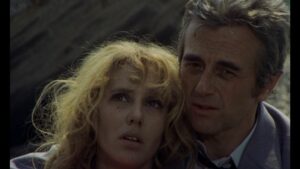
„How Far Away, How Near” is another Tadeusz Konwicki entry. Andrzej (Andrzej Łapicki) recalls his wartime fate and his friendship with Maks (Gustaw Holoubek), who committed suicide. The film abounds in surreal scenes with rich symbolism, and has no uniform time or place of action. It is an expression of artistic creation, while at the same time referring to the author’s autobiography and events from recent Polish history. “How Far Away, How Near” won many prestigious awards, including at the San Remo Festival.
22. “The Deluge” (“Potop”, 1974)
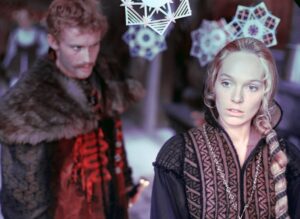
Jerzy Hoffaman went down in Polish cinematography primarily as the creator of screen adaptations of Henryk Sienkiewicz’s trilogy. The most outstanding of the three historical films, however, is 1974’s “The Deluge”. The plot of the picture revolves around the Swedish invasion of Poland in the mid-17th century. The main character of the film is Andrzej Kmicic, an Orsha ensign who, initially deceived by Prince Radziwill, joins the treacherous deal, but then undergoes a spiritual transformation and becomes a national hero fighting with dedication for the Jasna Góra monastery. A memorable creation of Kimicic was created by Daniel Olchbryski, while his lovely beloved Oleńka was played by Malgorzata Braunek. “The Deluge” won four Golden Lions, as well as an Academy Award nomination for Best Foreign Language Film.
23. “Promised Land” (“Ziemia obiecana”, 1975)
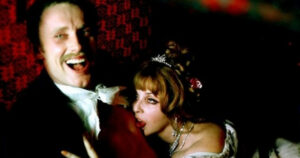
Andrzej Wajda has screened Polish literature many times, while “Promised Land” is among his most outstanding achievements in this regard. Interestingly, not at all the most outstanding of Wladyslaw Reymont’s novels, it has become a real gem on the screen. The movie is set at the turn of the 20th century in Lodz, a city of modern industry and capital. Three partners, a Pole Karol Borowiecki (Daniel Olbrychski), a German Maks Baum (Andrzej Sewryn) and a Jew Moryc Welt (Wojciech Pszoniak), open a textile factory. In addition to the aforementioned creations, Kalina Jędrusik (as Lucy Zucker) played a famous role in the film. “The Promised Land” earned an Oscar nomination.
24. “Nights and Days” (“Noce i dnie”, 1975)
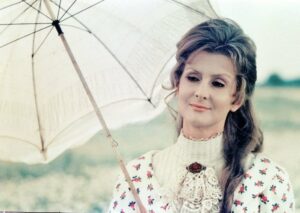
“Nights and Days” is another great film adaptation of Polish prose. Maria Dabrowska’s novel was masterfully transferred to the screen by Jerzy Antczak, and the leading roles were superbly created by Jadwiga Baranska and Jerzy Bińczycki. “Nights and Days” is the saga of the Niechcic family presented against the background of the dramatic events of Polish history from the defeat of the January Uprising to the outbreak of WWI. Barbara Ostrzeńska, after a severe love disappointment, marries Bogumil Niechcic without love. The couple leases a small landed estate, Pamiętów, and then moves to Serbinów. More children appear in the world, and life flows to the rhythm of passing nights and days. Antczak’s film was nominated for an Academy Award in addition to numerous national awards and an honorable mention in Berlin.
25. ”Camera Buff” (“Amator”, 1979)
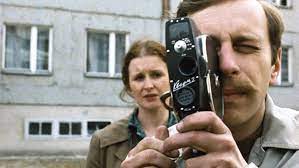
Krzysztof Kieslowski’s movie “Camera Buff” is an important work of cinema of moral concern. The title amateur is Filip Mosz (Jerzy Stuhr), an industrial worker who one day buys a camera. When he starts making amateur films, his life is completely changed. He is recognized at work and noticed by television. The protagonist’s documentary activities also contribute to the metamorphosis of his view of the world. Moshe becomes more and more involved in social issues, not noticing that along the way he rubs up against dangerous politics.
26. ”Camouflage” (“Barwy ochronne”, 1976)
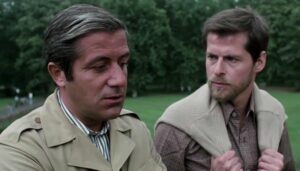
“Camouflage” is another important movie of the moral anxiety trend. In it, Krzysztof Zanussi presented a story set in an academic environment, during a student camp for linguists. During the reunion, an academic-ideological confrontation takes place between the staid docent Jakub Szelestowski (Zbigniew Zapasiewicz) and the young assistant Jarosław Kruszyński (Piotr Garlicki). The film won many awards, including honors in Tehran and Rotterdam.
27. “Wodzirej” (1977)

Feliks Falk’s film Wodzirej tells the story of an entertainer who tries to advance in his profession by resorting to the most disgusting methods, such as denunciation and deception. To make a career, he decides to eliminate his potential rivals at all costs. The character of Lutek Danielak was phenomenally played by Jerzy Stuhr, who received numerous awards for his performance, including at the Chicago Film Festival. Other roles, meanwhile, were played by Sława Kwaśniewska, Wiktor Sadecki, Michał Tarkowski and Ewa Kolasińska.
28. “Provincial Actors” (“Aktorzy prowincjonalni”, 1978)

Agnieszka Holland began her feature-length work with a psychological film, as exemplified by “Provincial Actors”. The action of the picture, as the title suggests, takes place in the province. Actors from a small town are to prepare a staging of Stanisław Wyspiański’s drama “Wyzwolenie” under the direction of a director from Warsaw. During the prob, however, a conflict arises between the actor playing the main role, Krzysztof (Tadeusz Huk), and the show’s creator (Tomasz Zygadło). The affair causes serious problems for the actor with his wife Anka (Halina Łabonarska). In addition to national awards, the film also received a FIPRESCI award at the Cannes Film Festival.
29. “Wśród nocnej ciszy” (1978)
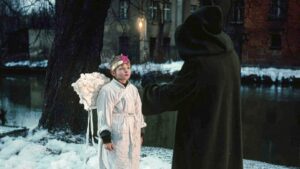
“Wśród nocnej ciszy”, directed by Tadeusz Chmielewski, is one of the best Polish crime films. The picture was based on the novel by Ladislav Fuchs, entitled “Příběh kriminálního rady”. The plot is set in the 1930s. The main character, Teofil Herman (Tomasz Zaliwski) is a commissioner in charge of the case of a serial killer of boys. At the same time, he himself is raising his adolescent son Wiktor (Piotr Łysak).
30. ”Death of a President” (“Śmierć Prezydenta”, 1977)
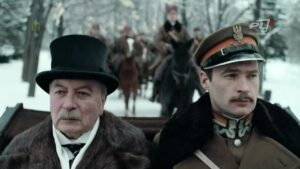
“Death of the President”, directed by Jerzy Kawalerowicz, was awarded the Golden Lions, as well as the Silver Bear at the Berlin Festival. The plot of the work was based on true events and is set in 1922. Newly elected Polish President Gabriel Narutowicz of the PSL formation is assassinated by a painter from the opposing political option (National Democracy) during a vernissage at Warsaw’s Zachęta Gallery. The role of the president was played by Zdzislaw Mrożewski, while his assassin, Eligiusz Niewiadomski, was played by Marek Walczewski.
31. “Nightmares” (“Zmory”, 1978)
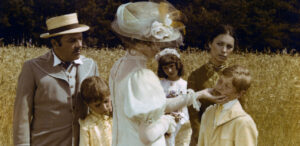
“Nightmares” is a movie by Wojciech Marczewski based on Emil Zegadłowicz’s novel of the same name. The picture, which belongs to psychological cinema, depicts the difficult period of adolescence of the main character, Mikolaj Srebrny (Piotr Lysak). Particularly critical here is the depiction of a school based on an authoritative theory of upbringing, using a system of severe punishment. The school bears parabolic features in Marczewski’s film with a clear political edge.
32. “Constans” (1980)

“Constans” is another movie by Krzysztof Zanussi that falls within the convention of psychological drama. It presents a portrait of a young man, Vytautas (Tadeusz Bradecki), trying to cope with life despite his noncomfornity. The protagonist has to face many difficult events. The film’s music was composed by Wojciech Kilar, and the cinematographer was Slawomir Idziak. The film accurately captures the social climate of Poland in the late 1970s and early 1980s – the growing marasm, despondency, and the citizens’ attempt to cope with petty fraud and ubiquitous corruption. Constans won international awards at Cannes and Panama, among others.
33. “The Quack” (“Znachor”, 1981)
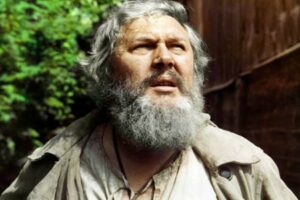
An adaptation of Tadeusz Dolęga-Mostowicz’s novel “The Quack” is one of the most popular Polish melodramas. In the first version of the 1937 film, directed by Michał Waszyński, the role of Professor Wilczur was played by a prominent pre-war actor, Kazimierz Junosza-Stępowski. In 1981, meanwhile, Jerzy Hoffman filmed Znachor with a great performance by Jerzy Bińczycki. The movie tells the story of a well-known and respected surgeon who, after being abandoned by his wife, tries to soothe his grief in alcohol. Unfortunately, he falls victim to a severe beating, as a result of which he loses his memory.
34.”Teddy Bear” (“Miś”, 1980)
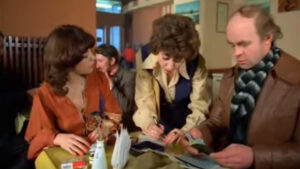
Stanislaw Bareja’s comedies are not only cult works of Polish filmmaking, but also an extremely accurate socio-political diagnosis of Poland in the 1970s and 1980s. “Teddy Bear” is, of course, a classic, the first part of a trilogy, the next links of which are Controlled Talks (1991) and Lynx (2007), but already filmed in a completely different reality. The main character of the comedy is a certain Ryszard Ochódzki (played by Stanislaw Tym), president of the “Rainbow” Sports Club. The man intends to take a large sum of money deposited in an English bank. The problem, however, is that his ex-wife Irena (Barbara Burska) is also entitled to withdraw the cash. So a race against time begins – who will reach England first and claim the fortune.
35. “Gwiezdny pył” (1982)
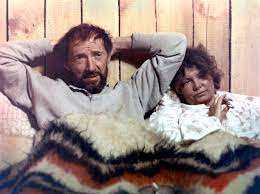
“Gwiezdny pył” is one of the films representing the peculiar cinema of Andrzej Kondratiuk. By the Pokrzywniczka river lives a married couple: the Old Man and the Old Woman. Life in harmony with nature flows with a slow daily rhythm. The Old One (Krzysztof Chamiec) is engaged in constructing original inventions, such as an electric mill wheel. The role of the Old One was played by Iga Cembrzynska, privately Kondratiuk’s wife and a great muse of his work. Stardust, like the earlier Fullness or The Four Seasons or The Spindle of Time, is an apotheosis of simple life and nature, which regulates the cycle of human existence.
36. “Man of Iron” (“Człowiek z żelaza”, 1981)
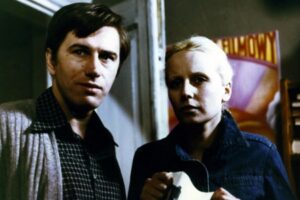
Andrzej Wajda’s “Man of Iron” is undoubtedly one of the most important works of Polish cinematography and the first Polish film to be awarded the Palme d’Or at Cannes. The picture is the second link in a series initiated by “Man of Marble” (1976). The first part concerned the fate of Mateusz Birkut (played by Jerzy Radziwiłowicz), a labor leader forgotten by the authorities. A young journalist Agnieszka (Krystyna Janda) becomes interested in his biography. The plot of “Man of Iron” is set in 1980 during the August strike of shipyard workers and the birth of Solidarity. This time the protagonist of the events is presented Maciej Tomczyk, Birkut’s son, actively involved in the activities of the strike committee. Journalist Winkel gets an assignment to realize a compromising material about him. It turns out that Tomczyk is the husband of Agnieszka, who once shot a film about his late father.
37. ”Blind Chance” (“Przypadek”, 1981)
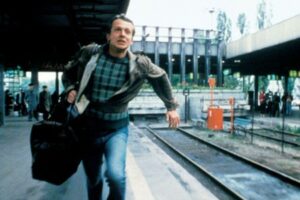
Krzysztof Kieslowski’s film “Blind Chance” had to wait as long as six years for its premiere, and even in 1987 it appeared on screens in a censored version. The main character of the work is a young student from Poznań, Witek Długosz (played by Bogusław Linda). One day the man decides to suspend his studies at the university and go to Warsaw. To do this, he goes to the train station. And from this bunk, the film presents three alternative versions of Witek’s biography, the key moment of which turns out to be whether the protagonist misses the train or travels with it to the capital. The case is a film that was later alluded to in many works of world cinema, such as “Run Lola Run” (1998).
38. “A Lonely Woman” (“Kobieta samotna”, 1981)
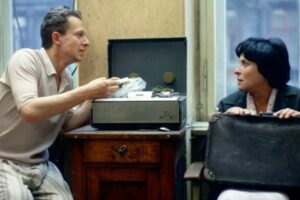
Agnieszka Holland’s movie “A Lonely Woman” is a poignant study of the plight of a single mother living in Poland in the late 1970s and early 1980s. Irena (Maria Chwalibóg) is a letter carrier and raises a several-year-old son. The woman leads a difficult life strewn with constant adversities. She has to struggle with housing problems, poverty, unkindness of teachers and neighbors. One day she meets a disabled man younger than herself, Jack (Boguslaw Linda). Hope for a change of fortune and love lead her to take desperate steps….
39. “The Mother of Kings” (“Matka Królów”, 1982)

Janusz Zaorski made “The Mother of Kings”, based on the novel by Kazimierz Brandys. The book came out in 1957 and was part of the current of the October Thaw. The plot of the work takes place over the course of several decades: from the sanctioned dictatorship of the 1930s to the dark times of Stalinism. The main character of the film is Felicja Król (Magda Teresa Wojcik), who after the death of her husband raises four sons alone. Each of them will collide with the irony of a great history. Its most painful moment, however, will turn out to be the post-war reality, when Klemens (Boguslaw Linda), a hero of the Polish underground, is accused of treason against the state and imprisoned in harsh conditions. The premiere of “The Mother of Kings” was delayed for five years due to the imposition of martial law. Despite this, the film received critical acclaim and won the Silver Bear at the Berlin Film Festival.
40. “Interrogation” (“Przesłuchanie”,1982)
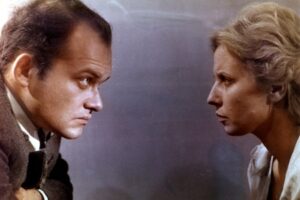
“Interrogation” is another movie dealing with the subject of Stalinism. The main character of Ryszard Bugajski’s work is singer Antonina Dziwisz, who is arrested without reason and sent to a tough prison. It is not known what she is accused of. The woman is subjected to cruel torture by the UB and spends several years in her cell. The role in “Interrogation” is one of the best and most recognized creations in Krystyna Janda’s career. The actress received an award for it at the Cannes Festival. Great roles were also played here by Janusz Gajos and Anna Romantowska. The film was stopped by censors and was not released until 1989.
41. “Sexmission” (“Seksmisja”, 1983)
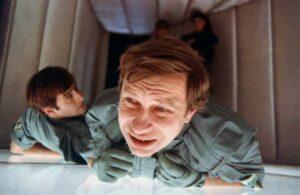
Juliusz Machulski’s comedy Sexmission is undoubtedly a classic of Polish cinema. The movie was shot in a science-fiction convention. In 2044, hibernated decades earlier, two men are awakened from a coma. It turns out that they are the only living male individuals on Earth. Maks (Jerzy Stuhr) and Albert (Olgierd Lukasiewicz) decide to rebel and escape from the totalitarian prison. In addition to a great comedy layer, the film also had allegorical overtones: it was a metaphor for communism as a system that deprived Polish representatives of the stronger sex of their masculinity.
42. “A Short Film About Killing” (“Krótki film o zabijaniu”, 1987)

Krzysztof Kieslowski’s “Decalogue” is one of the director’s most important achievements. Among a series of television films illustrating offenses against the Ten Commandments, there was also “Decalogue V” on the injunction “Thou shalt not kill.” The cinema version of the production was “A Short Film About Killing”. The main character of the picture is a young man Jacek (Miroslaw Baka), who murders a random cab driver. When he stands trial, his defense attorney Piotr (Krzysztof Globisz) becomes his lawyer. The piece is a voice in the discussion of the death penalty. The film won the Jury Prize at Cannes, as well as a FIPRESCI mention and the European Film Award.
43. “A Tale of Adam Mickiewicz’s ‘Forefathers’ Eve” (“Lawa”, 1989)
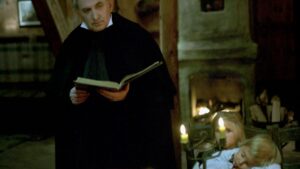
Tadeusz Konwicki’s “A Tale of Adam Mickiewicz’s ‘Forefathers’ Eve” is a film story inspired by one of the most important Polish national works – Adam Mickiewicz’s drama “Forefathers’ Eve”. The sequence of events depicted in the film reflects the achronological composition of the bard’s work. Thus, these are, in sequence: the Old Slavic ritual of the Grandfathers’ Eve taking place on All Saints’ Night in November (part II), the dilemmas of a lover abandoned by a woman (part IV), the transformation of Gustav into Konrad, the Great Improvisation, the ball at the Senator’s and the prison story of the national hero (part III). The title itself is a reference to Mickiewicz’s famous metaphor comparing the Polish nation to solidified volcanic lava, with a hard shell but a hot spirit (an impossible fire to extinguish). The young lover Gustav was played by Artur Zmijewski, and the mature Konrad by Gustaw Holoubek, whose magnificent rendition of The Great Imrpowers has gone down in the history of Polish cinema.
44. “Kogel-mogel” (1988)
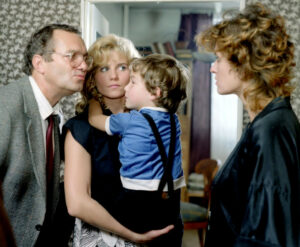
Roman Załuski’s “Kogel-mogel” is one of the few good romantic comedies in the history of Polish cinema. Kasia Solska (Grażyna Błecka-Kolska), a young girl from the province, gets the news that she has been accepted to study pedagogy in Warsaw. So the night before her wedding to an unloved bachelor chosen for her by her father, she decides to secretly run away from home. In the capital, however, it turns out that the dormitory during the vacations is closed, and she has to find a job and an apartment. Unexpectedly, however, she becomes the caretaker of the unruly Peter at the home of Mr. and Mrs. Wolanski. The film stars Ewa Kasprzyk, Zdzislaw Wajdern, Malgorzata Lorentowicz and Dariusz Siatkowski, among others.
45. “300 Miles to Heaven” (“300 mil do nieba”, 1989)
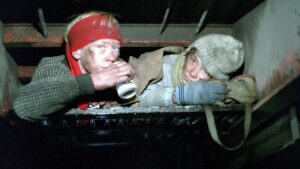
Maciej Dejczer’s movie “300 Miles to Heaven” is a famous story based on fact, awarded as the Best European Film of 1989. The work is set in the mid-1980s. Two teenage Zielinski brothers Jędrek (Rafał Zimowski) and Grześ (Wojciech Klata), along with their parents, are struggling with extreme poverty. The boys see no prospects for the future and dream of helping their family. They come up with the idea of going to Sweden. Hidden under the chassis of a truck, they make their way by ferry to Denmark. On the spot, a journalist begins to take an interest in their fate and publicizes the case. The brothers’ parents decide to support the children’s plans and, against the pressure of the Polish authorities, do not apply for the return of the children to Poland.
46. “Three Colors. Blue” (“Trzy kolory: niebieski”, 1993)

Although Kieslowski’s famous trilogy “Three Colors” is an international production, it is difficult to omit this work from the list of the greatest successes of Polish filmmakers, especially since it maintains ideological continuity with the director’s entire oeuvre. “Blue” tells the story of the grief of a young woman who loses her husband and daughter in an accident. The lead role was played by Juliette Binoche. The color metaphor, as in the other parts of the trilogy (White and Red) refers to the colors of the French flag and their symbolism related to the ideals of the Great Revolution. Among other awards, the film won the Golden Lion at the Venice International Film Festival.
47. “Escape from the Liberty Cinema” (“Ucieczka z kina Wolność”, 1990)
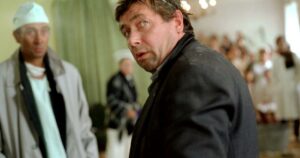
Wojciech Marczewski’s “Escape from the Liberty Cinema” is a film shot after the 1989 breakthrough and tells the story of the late 1980s, when society began to feel the invigorating wind of political change. The main character of the picture is film censor Rabkiewicz, who is sent to the eponymous Wolność cinema to check reports of iniquitous statements allegedly made from the screen during a screening of the work Dawn. The official is astonished to see that the actors playing in the film rebel against performing their assigned roles and engage in surreal discussions with the audience. Unexpectedly, Rabkevich himself becomes involved in them. “Escape from the Liberty Cinema” won many prestigious awards, with Janusz Gajos’ performance receiving the most recognition.
48. “Death Like a Slice of Bread” (“Śmierć jak kromka chleba”, 1994)
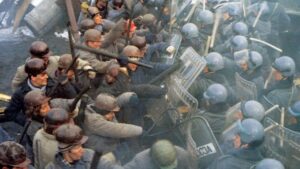
Kazimierz Kutz’s film “Death Like a Slice of Bread” is an important work of Polish cinematography. This is because it is an illustration of the dramatic events of the country’s recent history, namely the pacification of the Wujek mine in 1981. Kutz is a director who has devoted his entire oeuvre to the problems of Silesia and the formation of the identity of Silesians. The events depicted in the film begin on the night of December 12-13, when the chairman of Solidarity from the Wujek mine, Jan Ludwiczak, is arrested. The miners’ strike in protest against the imposition of martial law and the unlawful actions of the authorities is brutally suppressed on December 16. As a result of the intervention of the army and ZOMO troops, 9 miners are killed. The main roles in the film were played by Janusz Gajos, Jerzy Trela, Jerzy Radziwiłowicz and Mariusz Benoit.
49. “Pigs” (“Psy”,1992)

Wladyslaw Pasikowski’s “Pigs” is already a classic of Polish crime movie, as well as the flagship of the “bandit cinema” of the 1990s. Two former Security Service officers try to find a place for themselves in the new political and social reality of Poland after the fall of communism. Franz Mauer (Boguslaw Linda) enters the police structure, while Olo Żwirski (Marek Kondrad) gets involved with the mafia. Dogs showed the painful metamorphosis of the male role model, who in the new brutal world must become a tough, struggling man. The character of Mauer became, in a way, a symbol of a new generation, in which both a rebellious nature and a sensitivity and attitude to life marked by resignation and pessimism were concentrated. Dogs lived to see sequels in 1994 and 2020.
50. “Kiler” (1997)

Juliusz Machulski’s “Kiler” is a comedy that triumphed in popularity in the late 1990s. The main character of the film is Jerzy Kiler, a Warsaw cab driver (played by Cezary Pazura), accidentally taken by the mafia for a known paid assassin. The mistake opens the door for Kiler to the world of criminals. With this “promotion” the man receives several assassination assignments. In disentangling himself from the intrigue, the hero is helped by a beautiful journalist Ewa (Malgorzata Kozuchowska). The film stars Janusz Rewinski, Jan Englert, Jerzy Stuhr and Katarzyna Figura, among others.
51. “Young Wolves” (“Młode wilki”, 1995)

Jaroslaw Żamojda’s movie “Young Wolves” is a cult Polish film of the 1990s, being an important portrait of the generation of the late 1970s and early 1980s. Indeed, the “young wolves” of the title epitomize a completely new model of career and social advancement, in which what matters is not the traditional beaten paths based on long-term education, but the quick acquisition of money. Unfortunately, this is only possible through criminal means. Cichy (Jaroslaw Jakimowicz), Biedrona (Pawel Delag), Cobra (Tomasz Preniasz-Struś) and Scorpion (Zbigniew Suszyński) are members of the Black (Andrzej Kozlowski) gang. They involve their high school classmate, Prymus (Piotr Szewdes) the best high school graduate, in their activities. Soon they receive another assignment.
52. „In Haeven as it is on Earth” („U Pana Boga za piecem”, 1998)
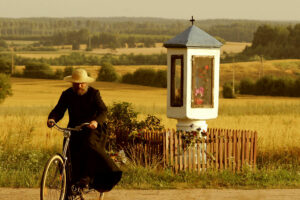
The movie „In Haeven as it is on Earth” by Jacek Bromski is one of the best Polish comedies after 89. The picture is the first link of the series, whose subsequent parts are “U Pana Boga w ogródku” (2007) and “U Pana Boga za miedzą” (2009). The comedy is set in the provinces of eastern Poland. A bus from Belarus is attacked by a local Georgian mafia, which robs the passengers. One of the victims is a young girl, Marusia (Ira Lachina). Ba the time of the investigation, the girl stays in a small village with the local organist Witek (Jan Wieczorkowski). It soon turns out that the woman has great vocal talent. Bromski’s comedy cultivates the myth of the Polish countryside as Arcadia – an ideal land where people live in harmony with nature and are faithful to basic moral values.
53. “With Fire and Sword” (“Ogniem i mieczem”, 1999)
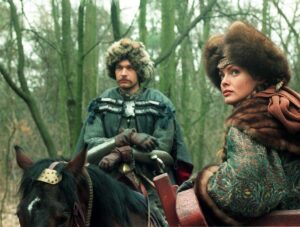
“With Fire and Sword” is one of the most important screen adaptations of Polish prose at the turn of the first and second decades of the 21st century. Jerzy Hoffman filmed the first chronological part of Henryk Sienkiewicz’s trilogy as the last due to censorship restrictions. After all, it was only after the fall of communism that it was possible to take up the subject of Polish-Ukrainian relations and the role of the Russian empire in shaping the map of Poland. The movie is set in the 1740s, during the uprising of Bohdan Khmelnytsky (played by Bohdan Stupka as the Hetman). Jan Skrzetuski (Michal Żebrowski), a soldier of Prince Wisniowiecki (Jan Seweryn), returns from a mission to Crimea. Along the way, he saves the life of Chmielnicki attacked by brigands, earning the gratitude of a Ukrainian dignitary. He also helps a beautiful noblewoman who is stuck with a relative in a shattered cart. He learns that she is Helena Kurcewiczówna (played by Izabella Scorupco). Despite the fact that her aunt intends to marry her off to the Cossack leader Jurko Bohun, Skrzetuski decides to propose to the girl. The film’s beautiful music was composed by Krzesimir Debski, and its leitmotif was used in the song promoting the film – Dumka na dwa serca performed by Edyta Górniak and Mieczyslaw Szczesniak.
54. “Love Stories” (“Historie miłosne”, 1997)
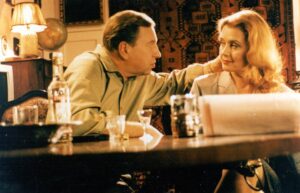
Jerzy Stuhr’s movie “Love Stories” is a drama presenting four tales of men’s emotional adventures. The protagonists of each story are, in turn, a research worker, a priest, a colonel and a prisoner. Into their “stabilized” lives unexpectedly creep accidents that throw the men out of their daily routine. The characters react differently to unexpected events and make radically different decisions. Interestingly, their attitudes are judged by a mysterious envoy of a supernatural order. All the male roles were played by Jerzy Stuhr himself, while the female characters were played by Katarzyna Figura, Dominika Ostalowska, Irina Alfiorova, Karolina Ostrozhna and Teresa Sawicka. The heavenly interviewer was played by Jerzy Nowak. Love Stories won the FIPRESCI Prize at the Venice Film Festival.
55. “The Debt” (“Dług”, 1999)
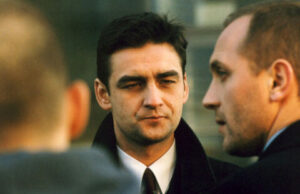
Krzysztof Krauze’s “The Debt” is an excellent crime movie based on the true story of Artur Brylinski and Slawomir Sikora, convicted of murder in 1997. The former was pardoned by President Aleksander Kwasniewksiegow in 2005, while the latter received an act of clemency from President Bronislaw Komorowski in 2010. The film reconstructs their story, with the names changed. The two young entrepreneurs: Stefan Kowalczyk (Jacek Borcuch) and Adam Borecki (Robert Gonera) have an idea for a great automotive business and try to get a loan from a bank for this investment. When they receive a negative decision, an old acquaintance of Setafan’s, Gerard Nowak (Andrzej Chyra), unexpectedly offers them his help. However, the cost of brokering the money presented by him exceeds the resources of the partners, so the men abandon their initial plans. Soon, however, Gerard begins to claim a loss of $6,000 due to the whole affair and demands the return of the invented debt. When Stefan and Adam refuse to meet his demands, the man begins to terrorize them… The film won numerous awards, including the Golden Lions in Gdynia, the Eagles and an honorable mention in Philadelphia.
56. “Day of the Wacko” (“Dzień świra”, 2002)
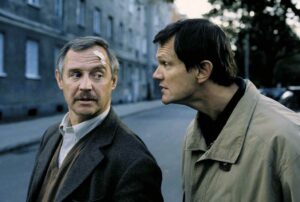
Marek Koterski’s film “Day of the Wacko” is one of the most important works of contemporary Polish cinema. The main character of the picture is Adaś Miauczyński (played by Marek Kondrat), a representative of the intelligentsia, who tries to somehow cope with the unfriendly reality. Once loving his job as a teacher-polonist, he experiences daily frustration and disillusionment with free Poland, whose absurdities, as it turned out, did not disappear at all with the fall of communism. In the character of Adas Miauczynski and his neurotic behavior, Polish audiences saw an accurate diagnosis of modern times, which gave Koterski’s film the status of a cult work. In addition to Kondrat, major roles in Day of the Pig were played by Michał Koterski, Janina Traczykówna, Andrzej Grabowski and Piotr Machalica.
57. “Edi” (2002)
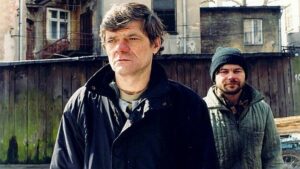
Piotr Trzaskalski’s “Edi” is a very good drama of manners, which focuses on the fate of people balancing on the periphery of social life – the homeless. Edi (played by Henryk Golębiewski) is a middle-aged homeless man who, along with his friend Jureczek (Jacek Braciak), makes a living by trading in scrap metal. His great passion is reading books found in dumpsters. For this reason, the two criminal friends decide to send his sister Ksiezniczka (Aleksandra Kisio) to him for tutoring. Soon, however, it turns out that the girl is pregnant, and suspicion of paternity falls on Edi… The film has won numerous awards, including Golden Lions, Eagles and honors at the Berlin Film Festival.
58. “My Nikifor” (“Mój Nikifor”, 2004)
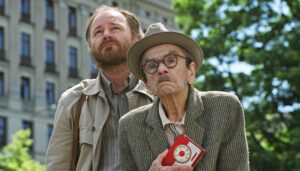
Krzysztof Krauze’s film “My Nikifor” is a beautiful story about an exceptional artist from Krynica, Nikifor, who is one of the most outstanding representatives of primitivist painting. The story is all the more original because the role of the artist is played by Krystyna Feldman, who was awarded many prestigious awards at home and abroad for her first leading role in her career. The film focuses on the relationship between the now elderly artist and Marian Wlosinski, who took on the care of the disabled Nikifor, half-closed in his own world.
59. “Savior Square” (“Plac Zbawiciela” 2006)

Krzysztof Krauze and Joanna Kos-Krauze’s “Savior Square” is an extremely powerful and moving story of family drama. A young married couple with two children are cheated by a real estate developer and, after losing the money they paid, must move in with the man’s mother, Teresa (Ewa Wnecel). Relations do not go well, and the atmosphere becomes increasingly tense. Teresa clearly does not accept daughter-in-law Beata, and Bartek (Arkadiusz Janiczek) begins to cheat on his wife. Everything leads to tragedy. Realized with almost documentary precision, the drama of the breakup of the family has a huge emotional charge and is deeply memorable. Jowita Budnik’s portrayal of Beata is an outstanding acting achievement.
60. “Katyn” (“Katyń”, 2007)
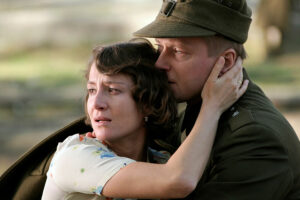
Andrzej Wajda’s film “Katyn” is an important work dealing with the particularly painful murder of Polish officers by the NKVD during World War II in Polish history. The director told the tragic events from the perspective of several families waiting for their loved ones interned by the Soviets after the Soviet aggression against Poland on September 17, 1939. Rotmistrz Andrzej (Artur Żmijewski), despite having the opportunity to escape, decides to honorably go into captivity with his comrades. His wife Anna (Maja Ostaszewska) does her best to survive the war along with her young daughter. In turn, the division gneral (played by Jan Englert) is awaited by his wife Róża (Danuta Stenka). No one suspects that Polish prisoners of war imprisoned by the Soviets will be bestially murdered. Katyn was nominated for an Academy Award for Best Foreign Language Film, and also won the European Film Award. The final scenes of the work recreating the course of the crime are harrowing. The film has become an important and powerful voice in the Polish historical narrative, as it has made clear to Western audiences what a monstrous crime the Katyn massacre was.
61. “General Nil” (2009)
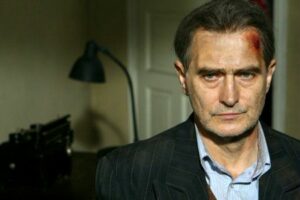
Ryszard Bugajski’s film “General Nil” is very good historical cinema. The work depicts the last years of the life and activities of General August Emil Fieldorf, nicknamed Nil, who was the commander of the Home Army’s Kedyw, and was viciously arrested after World War II. UB officers subjected him to brutal torture, and although they failed to break the commander, he was convicted of treason against the country on the basis of false confessions and executed in 1953. The role of the general was played by Olgierd Lukaszewicz. The film won numerous awards at home and abroad.
62. “Black Thursday” (“Czarny czwartek”, 2011)
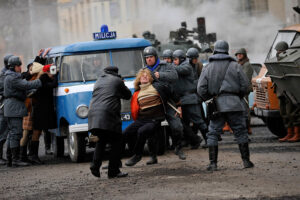
Antoni Krauze’s “Black Thursday” tells the story of the events of December 1970. During strikes on the Coast on December 17, army and police units opened fire on demonstrators, resulting in the deaths of 16 people. The film depicts the events from the perspective of one of the workers – Bruno Drywa and his loved ones. The leading roles were played by Michał Kowalski, Marta Honzatko, Marta Jankowska. The characters representing the authorities of the time were played by Wojciech Pszoniak (as Wladyslaw Gomulka), Piotr Fronczewski (as Zenon Kliszko), Piotr Garlicki (Jozef Cyrankiewicz) and Witold Debicki (Mieczyslaw Moczar).
63. “Tomorrow We’re Going to the Movies” (“Jutro idziemy do kina”, 2007)
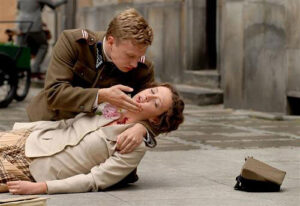
Television film by Michal Kwiecinski “Tomorrow We’re Going to the Movies” is a very good historical production showing the drama of war from the point of view of young people entering adulthood just before Hitler invaded Poland. Academic plans, first serious relationships, dreams of the future – all this is dispelled like a fog with the sound of the first German bombs falling on September 1, 1939. Starring Mateusz Damięcki, Antoni Pawlicki, Jakub Wesołowski, Anna Gzyra, Julia Pietrucha and Maria Niklińska.
64. “Snow White and Russian Red” (“Wojna polsko-ruska” 2009)
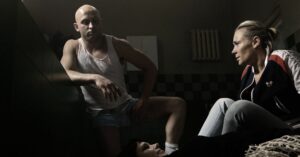
Xawery Zulawski’s “Snow White and Russian Red” is a successful screen adaptation of Dorota Maslowska’s famous novel published in 2003 under the same title. The main character of the picture is Silny (Borys Szyc), an unemployed “dresiarz” who constantly quarrels with his girlfriend Magda (Roma Gąsiorowska). The man spends his life in pubs, at alcoholic parties and drug conventions. He constantly gets into trouble and establishes casual relationships with various women. At the same time he makes advances to his girlfriend, who dreams of a miss career and travels to exotic countries.
65. “Jack Strong” (2014)
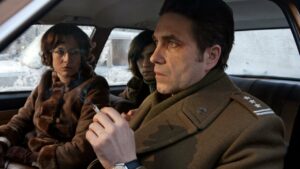
“Jack Strong” is a good political movie directed by Wladyslaw Pasikowski. It tells the gripping story of the clandestine activities of Colonel Ryszard Kuklinski, who worked for American intelligence precisely under the pseudonym Jack Strong. He began working with the CIA in 1972, and his findings played a key role in unmasking Soviet plans for aggression against Poland. Marcin Dorocinski played the lead role, his wife was played by Maja Ostaszewska, while his sons were played by Piotr Nerlewski and Jozef Pawlowski.
66. “Rose” (2011)
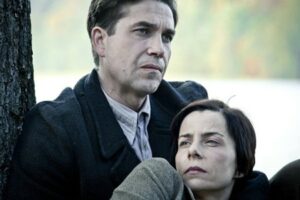
Wojciech Smarzowski is one of the most important directors of recent cinema, tackling important and difficult topics both historical and social. “Rose” is a film set just after the war in Masuria. Tadeusz, a soldier in the Home Army and participant in the Warsaw Uprising, after a terrible experience, reaches the home of Mazurka Rosa, the wife of a deceased Wehrmacht soldier. He begins to help her and her daughter on the farm and tries to defend the woman from attacks by Soviet bands of rapists. The lead roles are played by Marcin Dorocinski and Agata Kulesza. The film is a naturalistic and poignant portrayal of the dramatic events in Poland’s western lands just after World War II.
67. “The Mole” (“Kret”, 2011)
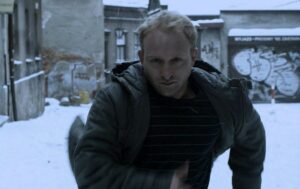
Rafael Lewandowski’s “The Mole” is a cinema that touches on the difficult and complicated subject of the entanglement of Polish citizens in the system of cooperation with the Security Service. Paweł (Borys Szyc) runs a small trading business with his father Zygmunt (Marian Dziędziel). One day, information appears in the press that Zygmunt was a secret agent in the past. This news completely changes the lives of the characters and significantly affects their relationship. Paul, however, feels that the truth has not been fully explained and begins to conduct his own investigation into the past.
68. “In Darkness” (“W ciemności”, 2011)
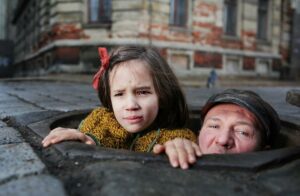
Agnieszka Holland’s movie “In Darkness” is an international co-production, telling the story of the Holocaust. The work is based on the novel Girl in a Green Sweater by Krystyna Chiger, as well as Robert Marshall’s work In the Sewers of Lvov. The main character of the picture is a Lvov sewer worker, Leopold Socha (played by Robert Więckiewicz), who, despite his initial dislike of Jews and his own greed, decides to risk his life to hide a dozen people in the sewers. In addition to Więckiewicz, important roles were played by Kinga Preis and Agnieszka Grochowska. The film In Darkness was nominated for an Academy Award. Along with the work Europe, Europe is a very important artistic statement of the Polish director on the Holocaust.
69. “Ida” (2013)
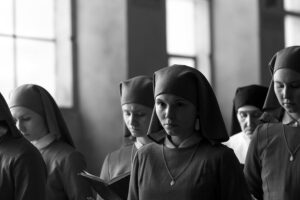
Pawel Pawlikowski’s “Ida” was a spectacular success, winning the 2014 Academy Award for Best Foreign Language Film, as well as many other prestigious awards, such as five European Film Awards. “Ida” is set in the early 1960s, and the main character (played by Agata Trzebuchowska), about to take her vows as a nun, is visited in the congregation by her aunt Wanda (Agata Kulesza). The relative reveals to the girl that they are both Jewish. The women decide to discover the truth about their past.
70. “You Are a God” (“Jesteś Bogiem”, 2012)
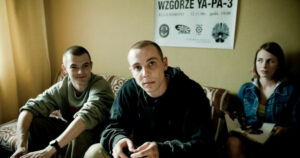
Leszek Dawid’s film “You Are a God” is an interestingly realized story of “Magik,” or Piotr Luszcz, the well-known singer of hip-hop bands Kaliber 44 and Paktofonika. The film shows the last years of the artist’s life, who committed suicide in 2000. The moving story about a group of young people from the rapper milieu is also a portrait of the generation growing up in the 1990s. It faithfully shows the reality of Polish block housing and the difficult start into adulthood of young people struggling with the lack of prospects and jobs. The lead role was played by Marcin Kowalczyk. The other members of the band were played by Dawid Ogrodnik (Rahim), Tomasz Schuchardt (Fokus), while the producer of Paktofonika’s album was played by Arkadiusz Jakubik.
71. “Suicide Room” (“Sala Sambójców”, 2011)

The most incisive statement of a Polish film about the generation living in virtual reality is Jan Komasa’s Suicide Room. Dominik (Jakub Gierszał) is a sensitive adolescent boy who often escapes into the world of the Internet. One day the protagonist meets a girl named Sylwia (Roma Gąsiorowska) online, who invites him to a place called “suicide room.” The film was awarded prestigious prizes, such as Golden Lions, Eagles, as well as several Golden Duck statuettes.
72. “Gods” (“Bogowie” 2014)

“Gods”, directed by Lukasz Palkowski, is an excellent film telling the story of Professor Zbigniew Religa’s revolutionary work in the field of medicine. The picture presents an extremely interesting portrait of the legend of Polish cardiac surgery, a man who had the courage and determination to initiate the performance of complex heart transplantation procedures in Poland. A wonderful creation of Professor Religa was created in the film by Tomasz Kot. Piotr Głowacki (as Marian Zembala) and Szymon Piotr Warszawski (as Andrzej Bochenek) also played very good roles.
73.”Body” (2015)

“Body” is one of Małgorzata Szumowska’s more famous films, awarded the Silver Bear at the Berlin Film Festival. The main characters of the picture are a prosecutor (Janusz Gajos) and his daughter Olga (Justyna Suwała), who severely experience death – of their mother and wife. Each of them deals with grief differently. The girl falls into anorexia. One day her therapist Anna (Maja Ostaszewska) finds that she has contacted a deceased woman close to them.
74. “The Last Family” (2016)

In “The Last Family”, Jan P. Matuszyński told the truly improbable, yet true story of the Beksinski family. The film shows the life of the famous clan over several decades. It is an attempt to create a portrait of Zdzislaw Beksinski, the famous painter, his wife Zofia and son Tomasz, as well as their mutual relationships. Critics especially appreciated the acting performances of Andrzej Seweryn as Zdzislaw and Aleksandra Konieczna as Beksinski’s wife and Tom’s mother.
75. “Loving Vincent” (2017)

“Loving Vincent” is a spectacular painting animation telling the story of the last stage of Vincent van Gogh’s life. This Polish-British production was directed by Dorota Kobiela and Hugh Welchman. The work was nominated for an Oscar in the category of best animated feature film. The picture received the European Film Award. The plot centers around an attempt to explain the mysterious circumstances of the artist’s death.
